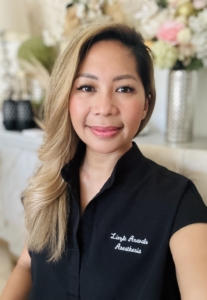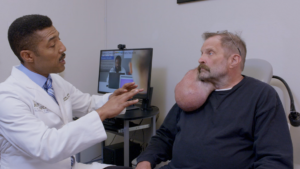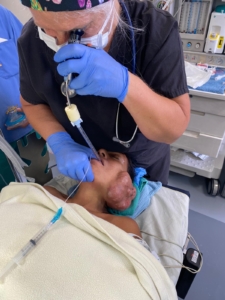In his practice, California-based surgeon Ryan Osborne, MD, FACS, has been taking on rare and unusual head and neck oncology cases for a long time. He primarily uses Certified Registered Nurse Anesthetists (CRNAs), also known as nurse anesthetists or nurse anesthesiologists, to provide anesthesia during surgeries.
“I do very difficult cases,” said Dr. Osborne, Director of Head and Neck Surgery at the Osborne Head and Neck Institute in Los Angeles. “I need people who are going to be thorough and comprehensive, and in my personal experience, I’ve found that to be CRNAs.”
CRNAs are highly experienced advanced practice registered nurses. They’re qualified to administer every type of anesthesia to all types of patients in any healthcare setting. Nurse anesthetists deliver comprehensive care using all accepted anesthetic techniques including general, regional, sedation, local and pain management. Because they are highly educated specialists, California, like many other states, allows CRNAs to administer anesthesia without physician supervision.
Laurie Hanna, CRNA, and Liezle Arevalo, CRNA, both work with Dr. Osborne and appear with him on the TLC show “Take My Tumor.” The show depicts patients with life-threatening tumors undergoing complicated and intense surgeries to remove them.
“These patients are coming from different states and even different countries to see Dr. Osborne,” Arevalo said. “We start preparing for these patients pre-operatively way in advance because the cases are difficult and may involve collaborating with several specialists pre-operatively. These cases are challenging, but they’re very satisfying.”

“With how difficult some of these cases are, Dr. Osborne has to trust us,” Hanna said. “As a team, we’ve developed a mutual trust that allows us to do cases other people wouldn’t do in an outpatient surgery setting.”
Dr. Osborne said CRNAs’ nursing background is part of what makes them such strong providers and why he uses them in his practice. On average, CRNAs have three and a half years of critical care nursing experience before entering a nurse anesthesiology program.
“Doctors don’t take care of patients, we give orders. And the truth is nurses take care of patients. I think there’s something about having that nursing background and then bringing it into the operating theater that gives CRNAs an advantage to connect with the patient,” he said. “It’s rare when you see a surgeon with a good bedside manner. We’re not really taught bedside manner, and we’re not really taught to care. We’re taught how to diagnose disease. But nurses are taught how to take care of people.”

CRNAs’ connection with patients is on display on “Take My Tumor.” One of the patients from the show who stands out to Hanna is a woman from Trinidad named Charmaine, who suffered from neurofibromatosis — a rare, progressive genetic disorder that causes non-cancerous tumors to grow in the nervous system and other parts of the body. She was covered in tumors from head to toe. Charmaine’s case was so extreme, Hanna said, it was a challenge to manage her airway and start an IV. The multitude of tumors around her mouth and nose made it impossible to get an adequate mask seal to ventilate her.
“Nobody dies because you can’t intubate them. They die because you can’t ventilate them,” Hanna said. “The scariest part of Charmaine’s case was the inability to effectively mask her.”
Hanna was required to use her critical thinking skills as a CRNA in order to proceed with Charmaine’s case. Dr. Osborne and Hanna made a joint decision to do the first and second surgeries under light sedation (versed, ketamine and small doses of propofol) with infiltration of local anesthesia. Hanna was able to provide oxygen via a nasal cannula. Charmaine required three surgeries to clear her airway before general endotracheal anesthesia could be safely induced.

One of the most rewarding parts of these surgeries, Hanna and Arevalo said, is changing the patients’ lives for the better. In Charmaine’s case, Hanna said, “Before the surgery, I don’t think she wanted to leave her home. She really struggled with what she looked like and how she wasn’t accepted by society. By the time she left, she looked completely different. I don’t think that you can underestimate what that did for her and for the quality of her life.”
Arevalo and Hanna said again and again, they’ve seen patients’ lives completely change after surgery. Arevalo described a young man who was isolated due to a tumor on his head that was the size of a small melon. Prior to surgery, he was unable to do many activities because the tumor prevented him from sweating, which put him at risk for heat stroke. Now he’s able to exercise and has said the surgery changed his life.
Hanna keeps in touch with a young woman who had a 20-pound tumor on her neck removed. The patient sends updates and photos of things she never would have been able to do before surgery, like travel and go shopping for new clothes.
When Hanna invited Arevalo to join the practice, she said, “I told Liezle, ‘This is not like any other practice that you’re ever going to go to. It’s different because you have autonomy and respect that you don’t have in other places, but you also get to change people’s lives in a way that is different.’”
Being a CRNA, Arevalo said, is part of what enables her to provide such life-changing care. “CRNAs have that extra special touch and put extra heart into caring for our patients. I think that’s what differentiates us from other providers.”